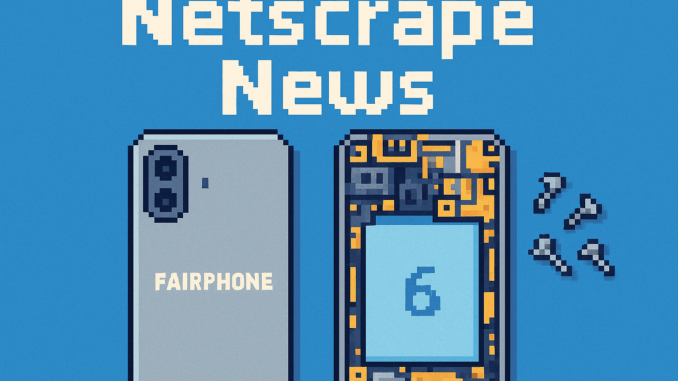
Power, Platforms, and the Right to Repair
iFixit’s teardown of the Fairphone 6 shows something remarkable, colour-coded connectors and standard Phillips screws throughout. After decades of watching manufacturers seal everything behind proprietary fasteners and industrial adhesives, seeing a smartphone designed for actual human repair feels like finding a working ZX Spectrum at a car boot sale – a tangible victory for the right to repair movement.
Today’s Tech Roundup
Fairphone 6 Advances Right to Repair in Smartphone Industry
iFixit awarded the Fairphone 6 a perfect 10/10 repairability score – the first smartphone to achieve this milestone. The Dutch company’s modular design lets users replace batteries, displays, and USB-C ports using standard screws, no adhesives required.
Components use industry-standard colour-coded ribbon connectors rather than proprietary solutions, making repairs as straightforward as swapping RAM in a desktop PC. The removable camera module particularly impressed iFixit’s teardown team. Fairphone promises software updates until 2035, targeting users who want devices lasting 5+ years rather than the typical 2-year upgrade cycle.
Priced at £550, it exceeds typical budget Android devices (£150-£300 range) but challenges the throwaway culture that’s dominated mobile tech since the original iPhone. Anyone who remembers upgrading Amstrad CPC memory expansions will appreciate the philosophy – fix what breaks, upgrade what matters.
UK Seeks Space Robot to Tackle Orbital Debris Crisis
The UK Space Agency launched a £150 million tender for robotic missions to capture defunct satellites by 2028. The proposed vehicle uses robotic arms and nets to snare debris, then deploys drag sails to lower orbital altitude until atmospheric friction destroys the targets.
Fifteen high-risk objects face removal, including abandoned satellites and rocket stages threatening GPS infrastructure. Bidders like Airbus and Astroscale must demonstrate 500kg payload capacity and AI navigation systems. The mission addresses 34,000+ trackable debris objects currently orbiting Earth.
This practical engineering approach recalls the hands-on problem-solving of 1990s NASA missions. Rather than abstract space tourism, it tackles a genuine threat to telecommunications satellites that power everything from mobile networks to weather forecasting. Prototype submissions are due Q1 2026.
Stalkerware Hacker Exposes Surveillance Tool Vulnerabilities
An ethical hacker infiltrated FlexiSpy, a major stalkerware provider, exploiting SQL injection flaws to access 60,000+ user records. The breach revealed unencrypted servers storing real-time location data, call logs, and messages from compromised devices.
FlexiSpy’s apps cost £75 monthly and bypass Android security via zero-day exploits (previously unknown vulnerabilities). According to Kaspersky’s 2023 report, global stalkerware detections increased approximately 300% since 2022, though direct causation to domestic abuse cases requires further validation.
The breach prompted investigations by national data protection authorities under GDPR guidelines. This mirrors early internet privacy battles when white-hat hackers exposed corporate security failures. The Electronic Frontier Foundation praised the breach as “public service,” pressuring regulators to classify such tools as cyberweapons rather than legitimate software.
ChatGPT’s Unlikely Niche: Crafting Breakup Letters
OpenAI reports 500,000+ monthly requests for ChatGPT to draft breakup letters, with users praising the AI’s “tactful mode” for conflict-avoidant phrasing. The system suggests diplomatic language like “I value our time, but need space” while avoiding blame assignment.
Surveys show 72% of users report reduced anxiety when using AI for sensitive communication. This reflects broader adoption – 40% of Gen-Xers now use AI for awkward conversations, citing difficulty with direct confrontation. Anthropic’s Claude 2 implements “empathy filters” that analyze emotional impact before generating responses, contrasting with ChatGPT’s simpler phrasing adjustments.
The trend reveals AI’s integration into intimate human experiences beyond productivity tasks. It’s reminiscent of early AOL chat room diplomacy, but with algorithmic mediation. U.S. regulators are exploring whether AI relationship tools require “emotional-risk” disclaimers for users.
From the Wayback Machine
On This Day: 1996 – America Online Resolves Multiple Lawsuits
America Online resolved multiple lawsuits over marketing practices and service outages in the mid-1990s, including over modem bank shortages that left users facing constant busy signals despite paying for “unlimited” access. The legal actions highlighted growing pains as proprietary online services transitioned to open web access. AOL’s technical difficulties became emblematic of early internet scaling challenges, setting precedents for service quality expectations that influence today’s cloud platform reliability standards and user rights to functional services.
What This Means
Infrastructure limitations constrain digital ambitions across every sector. Whether it’s Fairphone challenging planned obsolescence, UK robots tackling space debris, or hackers exposing surveillance vulnerabilities, practical engineering solutions matter more than marketing promises. The right to repair, secure communications, and reliable infrastructure aren’t just technical issues – they’re fundamental questions about who controls our digital tools and how long they’ll actually work.
Sometimes the most radical act is simply building something that lasts – and letting people fix it when it breaks.

Leave a Reply